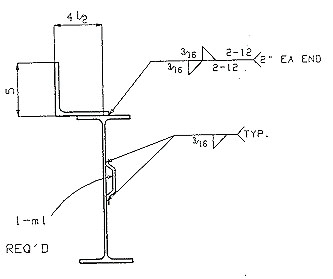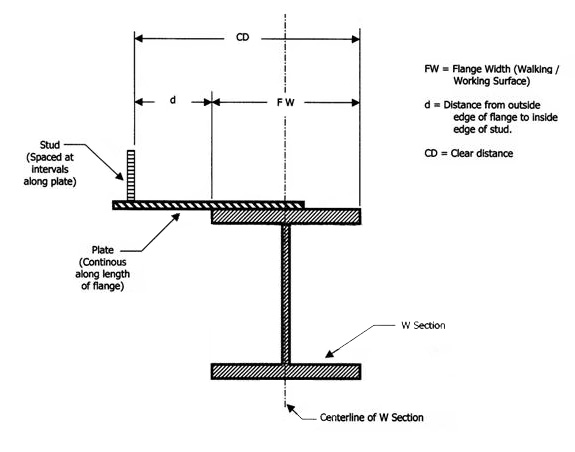- Standard Number:1926.754(c)(1)(i)
OSHA requirements are set by statute, standards and regulations. Our interpretation letters explain these requirements and how they apply to particular circumstances, but they cannot create additional employer obligations. This letter constitutes OSHA's interpretation of the requirements discussed. Note that our enforcement guidance may be affected by changes to OSHA rules. Also, from time to time we update our guidance in response to new information. To keep apprised of such developments, you can consult OSHA's website at https://www.osha.gov.
December 24, 2003
Mr. Richard C. Ward
Project Manager
The Pangere Corporation
Corporate Office
4050 West 4th Avenue
Gary, Indiana 46406-1718
Re: Whether shop-installed angle-iron running along the length of the top flange of a beam (with the upturned angle located out from the edge of the beam) violates 29 CFR 1926.754(c)(1)(i)?
Dear Mr. Ward:
This is in response to your letter dated April 9, 2003, to the Occupational Safety and Health Administration. You ask about the applicability of the restrictions on walking/working surfaces set forth in §1926.754(c)(1)(i). We apologize for the delay in responding.
We have paraphrased your question as follows:
Question: Section 1926.754(c)(1)(i) prohibits the attachment of shear connectors and other similar devices to the top flanges of steal beams prior to the installation of decking or other walking/working surfaces. We are considering the shop installation of a bent plate attachment that has an upturned angle running longitudinally along the length, but outside of the top flange of the steel beam (see Attachment A). Since the upturned leg of the angle is outside of the outer edge of the top flange, is it permissible to shop-install this plate without violating §1926.754(c)(1)(i)?
Answer
In 29 CFR Part 1926 Subpart R (Steel Erection), §1926.754(c)(1)(i) provides:
(c) Walking/working surfaces - (1) Shear connectors and other similar devices - (i) Tripping hazards. Shear connectors (such as headed steel studs, steel bars or steel lugs), reinforcing bars, deformed anchors or threaded studs shall not be attached to the top flanges of beams, joists or beam attachments so that they project vertically from or horizontally across the top flange of the member until after the metal decking, or other walking/working surface, has been installed.
Recently, we issued a letter to Mr. Zane Keniston on a question that closely parallels your inquiry. This interpretation will be included in a set of additional questions and answers to the Steel Erection Directive. The new interpretation, in part, follows:
Question: Scenario: a continuous steel plate is welded to the top flange of a perimeter beam. On the exterior edge of the plate, threaded studs are attached vertically at specified intervals (see diagram below). The purpose of the studs is to allow for the attachment of wood blocking used by the roofers. Is shop attachment of these studs a violation of §1926.754(c)(1)(i)?
Answer
. . . Under §1926.754(c)(1), "threaded studs" are prohibited from being installed prior to the decking where they project either vertically from the top flange of the beam, or horizontally across the top flange of the beam. As explained in the preamble of the final rule (volume 66 of the Federal Register, page 5213, January 18, 2001), "when attachments, like shear connectors, are shop-welded to the top flange of beams, the resulting projections can create a significant tripping hazard." These pose a tripping hazard because, during the steel erection process, the top flanges of the beams serve as a walking surface.
In this scenario, a continuous steel plate is welded to the top flange of the beam. This, in effect, extends the width of the top flange and becomes part of the walking surface. Since the studs project vertically from the (extended) top flange, they pose a tripping hazard to the workers walking on the beam. Therefore, the shop installation of these studs would be a violation of §1926.754(c)(1)(i).
In applying this interpretation to the bent plate beam attachment, a similar conclusion is reached. As noted in the above interpretation, the welding of the base of the angle to the top flange effectively extends the width of that flange and becomes part of the walking surface. Since the upturned angle rises vertically from the (extended) flange, the tripping hazard addressed by §1926.754(c)(1)(i) is created and the use of the described bent plate beam attachment violates that standard.
Finally, it is recognized that §1926.754(c)(1)(i) applies to "shear connectors and other similar devices." [Emphasis added.] Read as whole, the focus of the standard is on tripping hazards associated with field installed attachments.1 Thus, in the new interpretation, the fact that the "similar device" at issue was used to attach wood blocking rather than to enhance concrete composite action was not relevant to the application of the standard. Similarly, the fact that the device at issue in your scenario is used as a form in concrete work also does not affect the application of §1926.754(c)(1)(i). The shop installation of the device similarly creates a tripping hazard and would violate the standard.
If you need additional information, please contact us by fax at: U.S. Department of Labor, OSHA, Directorate of Construction, Office of Construction Standards and Guidance, fax # 202-693-1689. You can also contact us by mail at the above office, Room N3468, 200 Constitution Avenue, N.W., Washington, D.C. 20210, although there will be a delay in our receiving correspondence by mail.
Sincerely,
Russell B. Swanson, Director
Directorate of Construction
Attachment A

1 As stated in the Preamble to the Final Rule for Safety Standards for Steel Erection at 66 Fed. Reg. 5213 (January 18, 2001): "Paragraph (c) of the final rule sets forth requirements that address slipping/tripping hazards encountered when working on steel structures. * * * when attachments * * * are shop-welded to the top flange of beams* * *. Field installations of these attachments can significantly reduce exposure to this hazard." [back to text]


